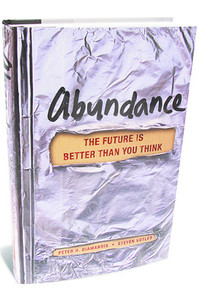Source of book image: online version of the WSJ review quoted and cited below.
(p. A13) Mr. Diamandis is the chairman and chief executive of the X Prize Foundation and the founder of more than a dozen high-tech companies. With his journalist co-author, he has produced a manifesto for the future that is grounded in practical solutions addressing the world’s most pressing concerns: overpopulation, food, water, energy, education, health care and freedom. The authors suggest that “humanity is now entering a period of radical transformation where technology has the potential to significantly raise the basic standard of living for every man, woman, and child on the planet.”
. . .
Predictions of a rosy future have a way of sounding as unrealistic as end-is-nigh forecasts. But Messrs. Diamandis and Kotler are not just dreamers. They lay out a plausible road map, discussing, among other things, the benefits of do-it-yourself tinkering–like the work by geneticist J. Craig Venter in beating the U.S. government in the race to sequence the human genome–and the growing willingness of techno-philanthropists like Bill Gates to tackle real-world problems.
The biggest hurdles, however, are not scientific or technological but political. There are still too many corrupt dictators and backward-looking governments keeping millions in penury. But as we have seen lately, the misruled have a way of throwing off despotic governments. With ever more people reaching for freedom, countless millions are tacitly embracing the Diamandis motto: “The best way to predict the future is to create it yourself.”
For the full review, see:
MICHAEL SHERMER. “BOOKSHELF; Defying the Doomsayers; Abundance” argues that growing technologies have the potential not only to spread information but to solve some of humanity’s most vexing problems.” The Wall Street Journal (Thurs., FEBRUARY 22, 2012): A13.
(Note: ellipsis added.)
The book being reviewed is:
Diamandis, Peter H., and Steven Kotler. Abundance: The Future Is Better Than You Think. New York: Free Press, 2012.





